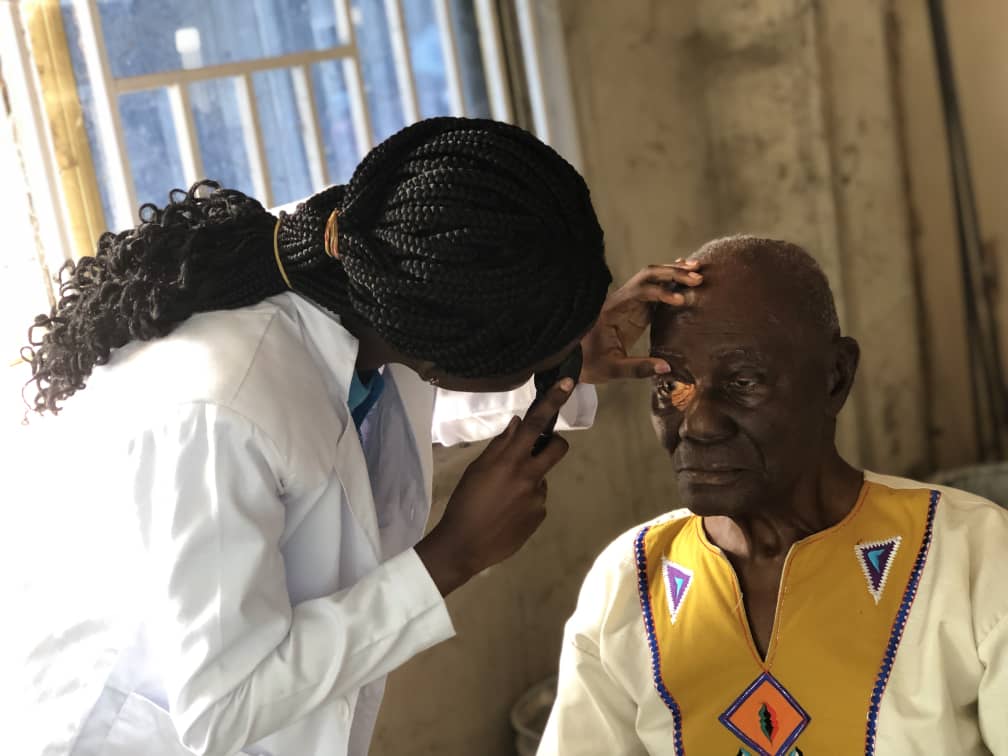Presbyopia is the irreversible loss of the accommodative ability of the eye that occurs due to aging. When we talk about accomodation we are referring to the eyes ability to changes its strength or power making it more adaptable to various distances while enabling us to see at the same time. As we grow this ability decreases. This decline occurs as a natural result of aging and will ultimately affect any person reaching advanced enough age. Despite its ubiquity, the exact mechanism behind presbyopia remains unknown however there are proposed theories behind how it happens. This will be well explained as you continue reading. In the first two decades of life accommodative strength has been shown to be relatively stable. By the age of 50, this accommodative amplitude has typically decreased drastically such that near aids are or may be required for good vision. It is the most common physiological change occurring in the adult eye and is thought to cause universal near vision impairment with advancing age. In our Epidemiology of Presbyopia today, we will be looking at the distribution and determinants of presbyopia.
Who is at Risk
The Question of Who is at risk is a common that is encountered everywhere almost all the time because people like to be in the know and protect themselves accordingly, unfortunate presbyopia is inescapable. The prevalence and magnitude of developing presbyopia is greatest after age 40. The risk of developing clinically early presbyopia is largely determined by a combination of hereditary factors and biologic variation. Although age is the primary predictive factor in the development of presbyopia, early loss of accommodative ability can be induced by certain systemic disease, medications, and trauma. It is also important to note that individuals whose occupations require extensive use of near vision and myopes often notice symptoms earlier than other similarly aged individuals.
When are they affected?
Presbyopia is primarily an inevitable, age-related condition and accordingly its prevalence in a given population is related to the percentage of individuals surviving to old age. The average age of those first reporting symptoms of presbyopia is between 42 and 44 years of age with a complete loss of accommodation typically occurring between the ages of 50-55 years

Where they are affected
Epidemiologic studies have been carried out in different locations around the world in various age, sex and ethnic groups, in an attempt to assess the prevalence rates of presbyopia. Results from this studies suggest that presbyopia is not confined to a particular geographical location. Though the prevalence differs from one location, community, state or country to another, presbyopia is a global health problem.
Why are they affected?
There are a number of factors that account for the development of presbyopia. Some of which include age, biological factors, hereditary as well as pathological conditions. The underlying cause for the loss of accommodation in presbyopia has yet to be fully elucidated and remains a topic of controversy amongst the medical community. Models for presbyopia can be generally divided into two categories referred to as lenticular and extra-lenticular theories. Lenticular theories hold that presbyopia results from age-related changes in the lens, capsule, and zonular fibers. Implicated changes in this category include sclerosis of the nuclear lens tissue, decreased distance between ciliary muscle and lens equator, and decreasing elasticity of the lens capsule. Proposed extra-lenticular causes include ciliary muscle dysfunction, loss of elasticity in the posterior zonules or choroid, and even decreasing resistance of the vitreous humor against the accommodating lens capsule.

Prevalence
Worldwide in 2005 over 1.04 billion people were estimated to suffer from presbyopia with around 410 million of them suffering from near vision loss due to lack of vision correction. 94% of those lacking proper correction were in developing nations. By the year 2020 the worldwide prevalence is expected to rise to 1.37 billion. The average age of those first reporting symptoms of presbyopia is between 42 and 44 years of age with a complete loss of accommodation typically occurring between the ages of 50-55 years. The prevalence of presbyopia in low- and middle-income countries is not well known, as most studies of refractive error in these countries have been limited to distance vision. There are few presbyopia studies that have used a population-based approach, making it difficult to draw conclusions about the prevalence of presbyopia in the general population.
Management/Treatment
The safest and least invasive management of presbyopia consists of corrective glasses lenses either as a separate set of reading glasses, contact lenses, bifocals, or progressive lenses. Your optometrist will aid you in making the right choice per your preference and your work and environment. For Presbyopic patients who may wish to be independent of glasses there are many surgical methods that may be recommended by your optometrist.

References
Click here to go to TwitterYou may read more about presbyopia in these journals, articles and on these sites. All images used are owned by @bettervision volunteers taken during outreach expeditions. Thanks for reading, don't forget to leave a comment if you enjoyed it, and have a nice time.
• Quantel-medical.com. 'Definition And Epidemiology Of Refractive Errors'.
• (Eyewiki.aao.org). 'Presbyopia – Eyewiki'.
• Burke AG, Patel I, Munoz B, Kayongoya A, McHiwa W, Schwarzwalder AW, West SK. Prevalence of presbyopia in rural Tanzania: a population-based study. Ophthalmology. 2006;113:723–7.
• Pointer JS. The presbyopic add, II. Age-related trend and a gender difference. Ophthalmic Physiol Opt. 1995;15:241–8
• Morny FK. Correlation between presbyopia, age and number of births of mothers in the Kumasi area of Ghana. Ophthalmic Physiol Opt. 1995;15:463–6.


You post has been manually curated by BDVoter Team! To know more about us please visit our website or join our Discord.
Hive Witness.Vote @bdcommunity as a
Are you a Splinterlands player? Get instant 3% cashback on every card purchase on MonsterMarket.io. MonsterMarket has the highest revenue sharing in the space, no minimum spending is required. Join MonsterMarket Discord.
BDVoter Team
Thanks for the love and support, just voted your witness, hope you continue to do great things for the hive community.
Interesting. This is the first time I will be reading about presbyopia. My high school biology limited us to just hypermetropia and myopia. Kudos to you
On a side note, did you take the images in this post yourself? If no, please always indicate the source of your images as the stemsocial community's guideline involves using images that do not have copyright issues.
Thanks for reading, and also yes all images have @bettervision copyright, we took them ourselves during our outreach expedition, this was stipulated in the post though.
Perhaps I missed that part. My apologies.
We will be looking forward to more participation in the community from you. Cheers
Danke Schon